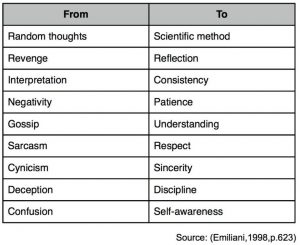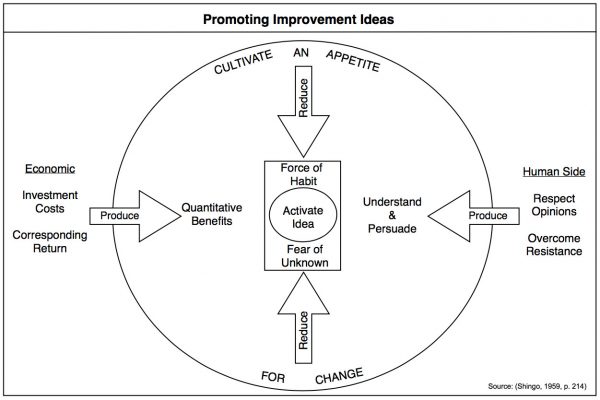Kaizen culture emerges as a result of peoples’ intelligence and energy. It is important to set in place systems to develop people who challenge, think, and continuously improve processes and products. At Toyota, the system is built around people who are deeply involved in the Toyota way (Liker & Morgan, 2006). Sako (1999) identifies that TPS strength lies in building a workforce that can implement and improve the workplace following TPS principles on their own.
Kaizen management is the core that keeps lean alive. Kaizen is considered as the heart in a human body. As long as the heart is pumping blood, the body can function. Similarly, as long as there are kaizen activities, the organisational goals can be achieved and capabilities can be improved. The tools and techniques can be thought of as the limbs and organs that have different functions. The people that bring all this together are similar to the brain, orchestrating everything.
To drive kaizen culture and get every single employee to accept and follow the principles is difficult. This is an extremely challenging task, where a great deal of passion and commitment are required . In the early days of developing TPS, Ohno realised the importance of the workforce. Womack highlights that for TPS to work, Ohno needed an extremely skilled and highly motivated workforce. Also, workers had to anticipate problems before they actually happened, and to plan for solutions.
The difficulty of having the workforce accept a kaizen culture can be down to mass-production system. Examples of kaizen principles are workers empowerment and standardised work. The principles can be seen as restricting worker freedom. Dealing with the resistance that occurs because of change is important. Management can deal with it in several different ways. First is education and communication, whereby management explains to the workforce the reasons behind what needs to be done and why. Secondly, is participation and involvement, whereby the workforce participate in the change initiative and drive it forward. Research shows that involvement leads to commitment rather than compliance. Third is facilitation and support, whereby managers develop the skills of the workforce and help them to adjust to the new changes.(Kotter & Schlesinger, 2008)
The workforce must already have or adjust their behaviors to fit with the kaizen culture. This is as important as management behavior. These behaviours benefit the company and create a continuous improvement community. These behaviors are listed in table below.


Employees’ motivation is important in a kaizen culture. Flexible manpower line helps to foster the workers’ motivation. It creates small work groups to discuss and generate suggestions, as well as, QC circles. Labor flexibility is another way to maintain workers’ motivation. Labor flexibility is achieved by job rotation, allocation, job enlargement and/or job enrichment (Saruta, 2006). Toyota took this a step further, by incorporating in-house training programs, by establishing the Toyota Institute to develop human resources (Toyota Environmental & Social Report, 2005; Saruta, 2006).
Toyota has defined a “T shaped human resources” for office and engineering position (professional staff). The cross bar of the “T” represents a broad range of skills (multilingual, operational knowledge) that a team member has. And, the vertical bar represents highly specialised knowledge and experience in a specific field. Toyota have three rules for developing office staff and engineers. During the first ten years staff receive thorough training in problem solving until promoted to assistant manager role. Secondly, although training develops employee skills, the focus must be on-the-job training (OJT). Finally, some chosen staff will act simultaneously as instructors and mentors. (Toyota Environmental & Social Report, 2005)
At Toyota, there is a specialised training program for core-skilled workers. The training is conducted at manufacturing sites, and recognises three ranks (A to C) depending on the level of skill acquired (Toyota Environmental & Social Report, 2005; Shimizu, 2009). The training process has a guideline that indicates that instructors will not teach everything; but, instead, the trainee him/herself are considered as the training subject (Saruta,2006). The trainee will discover the TPS rules and principles through the teaching and learning approach as a consequence of solving problems (Spear & Bowen, 1999). The program harnesses the training by individual learning, study groups, gaining experience through practical application, and supervisor coaching (Saruta,2006). During study groups, trainees share their different experiences, develop communication skills, leadership, and cooperation mindsets, as they take turns in leading the discussion about problems. (Shimizu, 2009; Saruta,2006)
Whilst Structuring the training process, companies should consider the educational effect. They need to think about human relations in the workplace (Saruta, 2006). The advantage of mentors and teachers is a duel educational opportunity. It provides the mentors with a new learning experience, as they give advice and instructions; and, a new learning curve for the skilled workers to become group leaders. The approach of building the complexity of experiments needs aligning with the trainee’s skills. At the beginning of the training, the trainee conducts single factor experiments (individual work elements), and then moves to system perspective.(Spear, 2004)
Another vital aspect that the workforce have to know, is the importance of teamwork. The focus should not be on individual work or star performers. Ohno (1978) gives a great analogy that illustrates the importance of team work. In an eight member rowing team with four on each side, if the team are not rowing in harmony the boat will zigzag. If one member of the team is stronger than the rest and would like to display it, the extra effort disturbs the progress of the boat. It also takes it off course. For the best output possible, the team needs to distribute the force equally, row evenly, and at the same depth. This analogy highlights the need for employees to understand the flow of work and support each other as a team.
To achieve high utilisation of workers in a kaizen culture, psychological flow needs to be created. To create this flow the skills must match the activity, have focused attention, set clear goals, receive immediate feedback, have a sense of control, and be free from externa
l concerns. This flow creates a cycle where the worker experiences pleasure worth repeating. They then participate and carry out kaizen activities for their own intrinsic reward.
Shigeo Shingo (1959) indicates the importance of understanding and persuasion to implement new ideas. He explains that if people understand the theory, it does not guarantee that they act on it; and that persuasion is achieved by emotion not by reason. This is presented in (Figure below). An important point Shingo highlights is that when peoples’ opinions differ from yours, the disagreement is with the means not the purpose. People must remember that there are multiple means to reach a common goal.


The workforce is a key pillar to the success of the kaizen culture. Managers and leaders need to encourage and celebrate the daily small improvements achieved by the workforce. They need to build the habit of improving on a daily basis by asking people: “What’s new today?”. Only when Kaizen is adopted by the workforce its full power will be unleashed and new highest achieved.
Next key pillar will be leadership and management system.


It works quite well for me
Nice posts! 🙂
___
Sanny